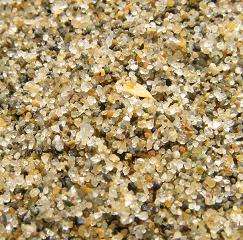February 16, 2009 weblog
Hydrophobic Sand Could Combat Desert Water Shortages

(PhysOrg.com) -- Water scarcity is a major problem for people living in desert areas, including much of the Middle East and Africa. According to the United Nations, more than 1.6 million people die every year due to lack of access to clean water.
Researchers at DIME Hydrophobic Materials, a company in the United Arab Emirates (UAE), along with German scientist Helmut F. Schulze, have developed hydrophobic sand using nanotechnology that could combat desertification and encourage plant growth in arid climates.
As DIME engineer Fahd Mohammad Saeed Hareb explains, their idea is to lay a 10-cm layer of waterproof sand beneath desert topsoil. The hydrophobic sand could serve as a water table to stop water from bleeding downward below the plants' roots. Normally, water quickly trickles down through the sand, requiring that farmers water their plants five or six times per day.
With the new layer of hydrophobic sand, farmers would only need to water their plants once per day, decreasing water use by up to 75 percent. Another benefit of the hydrophobic sand is that it prevents underground salt from passing through the plant roots, which can kill the plants.
The DIME researchers aren't revealing the precise nano coating used for their hydrophobic sand for proprietary reasons, calling the top-secret additive SP-HFS 1609. Other forms of hydrophobic sand are already on the market, which are usually coated with water-repellant silicas and used for cleaning up oil spills and other applications.
DIME's hydrophobic coating has been approved by Germany's Federal Environment Agency (FEA), which has issued the product a no-objection certificate declaring it to be ecologically safe. It takes about 30-45 seconds to coat a sand particle, and DIME's manufacturing facility can produce 3,000 tonnes of sand per day.
Other institutions are investigating the hydrophobic sand, including UAE University. For instance, researchers at the university are conducting tests to see if rice - which is usually grown in water-soaked fields - can be successfully grown in desert conditions. In general, their tests have shown that various plants benefit from the hydrophobic sand, such as by growing healthier roots, but the researchers said the tests are only half complete.
As the population increases and rivers run dry, water scarcity is expected to increase over the next decades in desert regions. In the Middle East and North Africa, 85 percent of the water is used for irrigation, so decreasing this requirement could help meet the urban demand and possibly prevent future humanitarian disasters.
via: Xpress
© 2009 PhysOrg.com





















